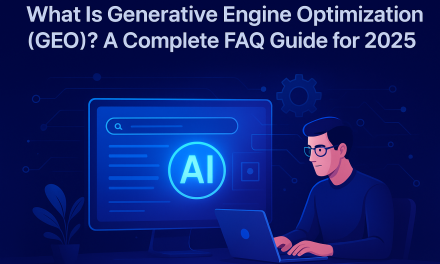Introduction — The AI Disruption in Search
Search engines aren’t what they used to be.
In 2025, AI and Generative Search Experiences (SGE) have transformed how users discover information — and how brands must optimize content.
Instead of ranking for keywords alone, SEO now revolves around entities, context, and user intent. In this article, we’ll explore how AI search works, what’s changing in the SEO landscape, and how to future-proof your content strategy for the AI era.
What Is Generative Search and Why It Matters
Generative Search is powered by AI models that generate contextual answers instead of just showing blue links.
Tools like Google SGE, Perplexity AI, ChatGPT Search, and You.com deliver summarized, conversational results.
Key Characteristics:
- Combines traditional search with AI-generated summaries.
- Focuses on intent matching, not keyword density.
- Rewards trustworthy, entity-rich content verified by AI systems.
Pro Tip: Optimize for AI visibility, not just Google ranking. AI engines crawl your entities, authors, and context — not just your keywords.
How AI Is Changing Traditional SEO
AI search changes the rules of engagement for visibility and ranking.
Here’s how:
| Old SEO | New AI-Driven SEO |
|---|---|
| Keyword Matching | Intent & Context Understanding |
| Backlinks Count | Entity Relationships & Trust Signals |
| CTR Optimization | Engagement & Relevance Scores |
| On-Page Keywords | Semantic Clustering & EEAT |
3 Core Shifts to Adapt:
- Entity-First Indexing: Google now associates your brand with concepts, not just terms.
- Content Contextualization: Surrounding terms and relationships determine visibility.
- AI Summarization Readiness: Your content must feed LLMs clean, structured, factual data.
How to Optimize for Generative Engine Optimization (GEO)
GEO — Generative Engine Optimization — is the new frontier of SEO.
To rank (or appear) in AI-generated summaries, your content should:
- Contain structured data and schema markup (FAQPage, HowTo, Article).
- Use clear factual sentences that LLMs can quote confidently.
- Include sources, statistics, and expert opinions to boost trust scores.
- Leverage semantic synonyms (e.g., agency, provider, consultant) for entity recognition.
- Maintain author EEAT signals — expertise, experience, author bio markup.
Checklist: GEO-Ready Page
- Entity-focused title
- JSON-LD schema
- Internal links to topical clusters
- Trust symbols (author page, references)
- Clear summaries for AI extraction
The Role of Structured Data and Entities
Structured data is the bridge between your content and AI understanding.
It tells generative engines what your content means — not just what it says.
Types of Schema That Matter Most in 2025:
Article→ For contextual discoveryFAQPage→ To appear in conversational AI snippetsHowTo→ For instructional content (high SGE visibility)BreadcrumbList→ To support topical hierarchy
Example:
If you’re writing about “AI SEO Tools,” adding Product and Review schema ensures your data feeds both Google SGE and Bing Copilot with structured credibility.





